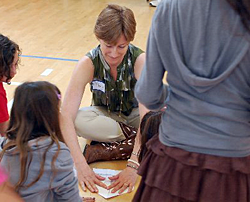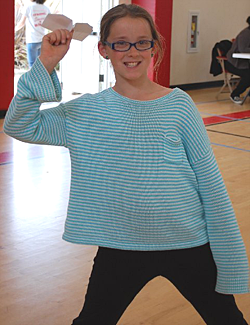Girls at After-school Program Science Event Explore Paper Airplanes
Hands-on engineering doesn't always require high-tech materials. Armed with a stack of paper and the steps to folding a basic dart airplane, a volunteer leads a paper airplane station at a local science exposition and realizes, with surprise, that folding planes isn't something all kids know how to do! With guidance, paper airplane folding can lead to some far-flying—and fun—aerodynamics exploration.
Along with origami fortune tellers
When Dr. Mary Raven, Microscopy Facility Director at the Neuroscience Research Institute and Neuroscience Research Institute & department of Molecular, Cellular & Developmental Biology, University of California, Santa Barbara, volunteered at her daughter's after-school program's annual science fair, she set up a paper airplane station so that the girls could experiment with the aerodynamics and physics of different plane designs. To get the most out of a hands-on comparative plane folding experiment, the kids folding the planes need to be comfortable with basic folding steps. Mary assumed most of the girls would have some history with paper airplanes. To her surprise, she discovered that folding paper airplanes was not something with which all the girls had experience. In the end, the girls that visited Mary's station at the Girls Inc. science fair got a crash course in basic folding, a fun dose of engineering, a nifty takeaway (paper airplane), and a great hands-on science experience.
Science After School
Mary's daughter, now in fourth grade, has been attending a local Girls Inc. after-school program since kindergarten, and Mary has been volunteering, each year, to lead a hands-on exploration with the girls at the science fair. According to Mary, science is typically part of the program schedule at Girls Inc., and when students request their top choice classes, engaging science-themed options like a Mad Scientist club are part of the available offering. But science really heats up with the yearly science expo when the girls get hands-on with a wide range of science and engineering activities.
"When you think science fair, you might think girls calmly presenting their projects" says Mary. "But the Girls Inc. science fair is more of a hands-on science show. Imagine 150 excited girls aged 5-12 running from station to station, and you have our Girls Inc. science fair."
At the science fair, various exploratory stations are set up for the girls to cycle through. This year, Mary says the stations included a math station, one focused on earthquakes, one on rocket launchers, one on hand washing (and visualizing germs with Glo Germ), a microscope-based station, and one featuring an iguana. The diverse offerings give the girls the chance to experience a number of different areas of science—who knows what might catch a young girl's imagination and spark lifelong interest—but as Mary can attest, 150 participants cycling through a hands-on science activity can be a challenge!
"I don't work with children for a living, and having one girl at home in no way prepares you for the experience of 150 excited girls asking every question imaginable," admits Mary. "I've tried several projects with the girls (prism optics, sun-prints, brain dissections), and I'm usually disappointed in my ability to share anything meaningful with a mass of swarming girls."
This year, Mary spotted a project at Science Buddies and thought it might be perfect for the science fair. "When I saw the experiment How Far Will It Fly? Build & Test Paper Planes with Different Drag posted on Science Buddies, I thought, 'hey, that looks like it might adapt to the wild of the Girls Inc. science fair.'"
Preparing for Hands-on Science with Kids
Having selected her activity for the fair, Mary spent time determining how best to convert the science "project" (something written with a single student performing a science experiment in mind) into a short-term hands-on activity that girls could do on the spot. When converting a full-scale project to an immediate and short-term activity, understanding both the audience and the main science concepts you want to get across is important. You want to craft the activity in such a way that the students are engaged and that there is a clear scientific takeaway.
Knowing in advance that girls would cycle through at varying times and that those at her station would all be in various stages of the activity at the same time, Mary planned ahead. She first made a poster that showed the basic steps for folding a simple dart plane. "I have learned the girls don't stop to read words," says Mary, "but I thought the examples might help."
She then gathered supplies: a stack of paper, a ruler, tape, scissors, and a clipboard for recording results. "I marked off the gym in 5 foot increments," says Mary, "and then with my poster board set up and papers at the ready, I waited for the girls to appear." Mary was ready, but she hadn't counted on the fact that not all of the girls had folded planes before. Even with the steps for folding a dart plane on the poster, folding the plane proved a challenge for some of the girls. "The first few girls trickled into the gym, and I quickly learned I was going to be walking the girls through folding the planes."
On the spot, Mary had to adapt and refocus her hands-on engineering activity. Testing multiple plane designs might not be possible; certainly, building three different planes with each girl was out of the question, says Mary. "I was a little surprised at how unfamiliar the girls were at folding paper. I was also a little disturbed to learn they called lengthwise folds 'hot dog' and widthwise folds 'hamburger,'" recalls Mary. Still, Mary and the girls stuck with it. "Some of the girls wanted me to fold [the plane] for them, but I think folding is a great 3D spatial skill, and using their own hands was important."
Despite the rocky start, "all the girls were able to fold a plane with help," says Mary. Not only were they able to fold a plane, but they were excited when they finished their planes. The immediate satisfaction of the project was evident for the girls who struggled through plane folding at Mary's station. "They were thrilled at how well the dart flew once it was complete."
Putting the Science in the Air
Rather than building multiple planes each, each girl flew her plane three times, and they took measurements and determined the average. Mary then guided the girls in modifying their original plane. "We added flaps in the back, and I asked the girls what they thought the flaps would do to the plane. None of the girls were certain what would happen, but when they tested the plane, they quickly realized the plane didn't fly well at all," says Mary. "They were able to deduce that the flaps were somehow blocking the airflow, and some girls realized that unfolding the flaps restored the plane's flying capability. I thought that was a great result!"
"I think making the planes was empowering for the girls," says Mary. "It gave them a tool to experiment with. They were excited to try flying it and to determine the best way to launch it. As much as I like the data collection and analysis part of the experiment, my favorite part was how the girls seemed to understand the manipulation. The concept of drag wasn't something they had heard of, and it isn't something they were likely to pick-up from a diagram. Still, after a couple of plane flights, they had a mental image."
And that's what it's all about, seeing the science in action, the cause and effect, the principles of science, like drag, and realizing that changing just one variable can make a dramatic difference. For Mary, this year's event was eye-opening, but she is happy with how it turned out and happy with the project she used as the basis for her activity. "I liked the aerodynamics (activity) because it is mostly hands-on interactive time, and the girls had something they could keep (the plane). Waiting is a killer in this format, and they love having something to take home."
"Overall, I'm very happy with the results although I still haven't achieved my vision of somehow ordering the disorder at my science fair table. If I had 4 volunteers, maybe?"
The Importance of a Single Volunteer and Role Model
We can't wait to see what Mary tries at next year's science fair, but we are sure that the girls who passed through her station this year benefited from having an interested adult take time to demonstrate, explain, guide, and encourage them to explore, question, and hypothesize.
"I think it is really important that the girls have contact with female scientist and engineers (or any scientist/engineer)," notes Mary. "Girls are very influenced by the female role models in their life. If you ask them why they are considering the career choice they are exploring, it is usually a female role model or relative that leads them to consider the option."
Note: After the fair, Mary suggested to the after-school program that enrichment programs in origami or in plane folding might be a great addition to the offerings. Do your kids and students fold paper airplanes now and again? If not, or if you are not sure, open up the basic dart instructions and grab a stack of paper. There are planes to be folded!
You Might Also Enjoy These Related Posts:
- 15 STEM Gifts & Science Kits You'll Feel Good About Giving
- 13 Boat Science and Submarine Science Projects and Experiments
- July 4th STEM! Summer Science Picks for Independence Day!
- 12 Science Kits for Summer Science Experiments and Discovery
- 15 Science Projects to Make and Give for Father's Day
- Ready, Set, Go! (Awesome Summer Science Experiments)
- Awesome Summer Science Experiments
- 10 STEM Activities with Cardboard Tubes











